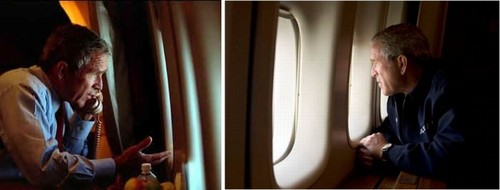I’ve been collecting a bunch of Last Sforza Posts in my browser tabs for a few weeks now; they just kept coming, but I wasn’t in the mood. Then I thought I’d put together some grand summary of the Bush era’s strategies for image use and manipulation, but I was definitely not in the mood for that. So here are some things I’ve been seeing, last things first:
But it seems problematic to me that the entire official web presence of the Bush administration, as tainted and manipulative or enraging as you may think it is, just gets wiped clean from the web like that. People need to remember, reference, discuss, and link to that publicly owned, previously published information; it shouldn’t be tossed to the curb like a dead plant or buried in the National Archive backup tape repository. So. Now that it’s too late to ask, has anyone been saving archived versions of the White House website? The pages saved by places I’d normally rely on–The Internet Archive and The Memory Hole–are woefully spotty and non-existent, respectively.

Should I really have to wait five years and file a Freedom of Information Act request to see the Christmas 2003 Real Video file of Karl Rove reading “Santa’s New Reindeer”? I don’t think so. As much as some might like to, we can’t just wipe the server clean of the last eight years “as if it never happened.”
archive update: Kate emailed with the news that a January 2009 snapshot of the old White House website is available at http://www.georgewbushlibrary.gov/white-house/. Alas, though it shows up in the search results, all mentions of Karl Rove’s reading of Santa’s New Reindeer have been scrubbed.

What hasn’t been mentioned is the controversies around each image: in May 2002, the GOP was criticized for offering $150 commemorative prints of the Sept. 11th photo to party donors. And in Jan. 2006, the White House News Photographers Association mentioned the Katrina image in their protest of the media’s use of official White House photographs.
GWB explicitly mentions just looking out the window of AF1 instead of landing and surveying the destruction himself–which, wasn’t a mistake, he argues, because if he’d gotten involved, it would have pulled police and emergency response personnel from the scene. As if the only power he had was the power of the photo-op.
And he cops to how the “Mission Accomplished” banner might have been a mistake, too, Even though the banner was just a bit player in the entire victory declaration on the USS Abraham Lincoln, and the whole show was hailed as the masterstroke of a conquering hero until months later when, it turned out, the mission was not, in fact, accomplished. And it wasn’t even a mission. And even though Bush had already thrown Scott Sforza under the bus once the banner became a controversial symbol of that failure: ”I know it was attributed somehow to some ingenious advance man from my staff. They weren’t that ingenious, by the way.”
Did Bush really see his job as the Imagemaker in Chief? Was he governing by speech and staged photo-op? Or were those the products he was selling to the media while the Administration’s less photogenic missions were being accomplished elsewhere? Watching Bush conversate with the White House press corps, I can’t help but feel like he’s talking shop–their shop, or their shared shop with them, which reminds me of a Karl Rove comment somewhere about treating the press, not as a representative of The People, but as a separate interest group that needed to be dealt with on its own terms. I can’t help but come out of the Bush era with the nagging sense that, based on the hard facts of government expenditure, agency destruction and mismanagement, regulatory neutering, massive contractor folly, and even military-backed destabilization, someone’s agenda was being pursued and executed while we were distracted by the daily news cycle. I await the realpolitik reading of the Bush/Cheney years to see an analysis of whose interests were successfully served or benefited by what’s popularly perceived as “failure.”
THE BUSH AESTHETIC: IMAGES AS ACTIONS
The Frankfurter Rundschau‘s Arno Widmann spoke with art historian Horst Bredekamp about the power of images and politics. For Bredekamp, President Bush attempted to reunite images with reality. Where Clinton was a master at staging photo opportunities for the press, Bush dislikes the media and attempted to cleanse images of all traces of showmanship by relinking them to actions.
“The politics of the image under George Bush is very complex and very difficult to analyze,” Bredekamp told the newspaper. “It was, if I observed correctly, at first an attempt to leave Hollywood high and dry, so to speak. Bush hates Hollywood. He hates television; he scorns basically all media.” Far from identifying Bush as a man of words, Bredekamp characterizes the exiting president as a man of actions. “He attempted to appear as a nonshowman of action. Today, we can no longer imagine why he was reelected. But this is one of the reasons.” Using images to illustrate actions belonged to the early media approach of the administration that Bush developed with Dick Cheney and Donald Rumsfeld. “The suspicion that an image was only show–that suspicion was supposed to be taken away from the image,” explains Bredekamp, who qualifies Bush as an antipostmodern for shying away from the world of simulacra and simulations celebrated in the 1990s. “The radical bond of images with things and actions–that was his antimodel. Against Hollywood. Also, his so-embarassingly handmade MISSION ACCOMPLISHED staging on the aircraft carrier lies in this line of bringing back images to a concrete bond with reality.”
W. T. F.??? Do things really look so different over there? On paper, Bredekamp looks to be an expert on the history of political imagery. But by the time I got to the utterly ahistorical “so-embarassingly handmade MISSION ACCOMPLISHED staging” comment, the good doctor had managed to burn through all the credibility on the entire continent. I tried reading and Google translating the original interview, but my German’s not good enough to say that Allen’s translations are off, so I assume they’re fine.
translation update: and I’d be wrong. Christian emailed from Germany to correct the auto-translation of “so-embarassingly handmade”: The original says ‘so peinlich-handwerkliche Inszenierung’. Its actual meaning comes close to ‘painstakingly crafted staging,’ in that considerable craftsmanship was used for the staging… While ‘peinlich’ has come to mean ’embarrassing’ its root is literally ‘painful’ or ‘under pain’.
‘peinlich’ can be used in combination with certain other words for stressing their meaning and suggesting extreme care for detail.” So there you have it.
I can only assume that he means to add a layer of strategy on top of all his image vs action talk. If there’s one over-arching criticism of the Bush years that sticks, it’s failure of their attempt to make reality by controlling the images and accounts of what the government was doing. It reminds me once again of Joan Didion’s masterful 1997 takedown of Dinesh D’Souza’s paean to Ronald Reagan in the NY Review of Books. Didion unpacks the conservative orthodoxy about Reagan’s greatest historical “accomplishments,” only to find that they’re all speeches, scenes from a script:
This president [i.e., Reagan, but half dozen of one… -ed.] who was not a marionette would be shown making decisions, and not only that: the decisions he was shown making (or more often in this instance, where rhetoric was soon understood to be interchangeable with action, the speeches he was shown making) would have demonstrable, preferably Manichean, results.
And so it continued. Or continues. The Sforza is dead! Long live the Sforza!
